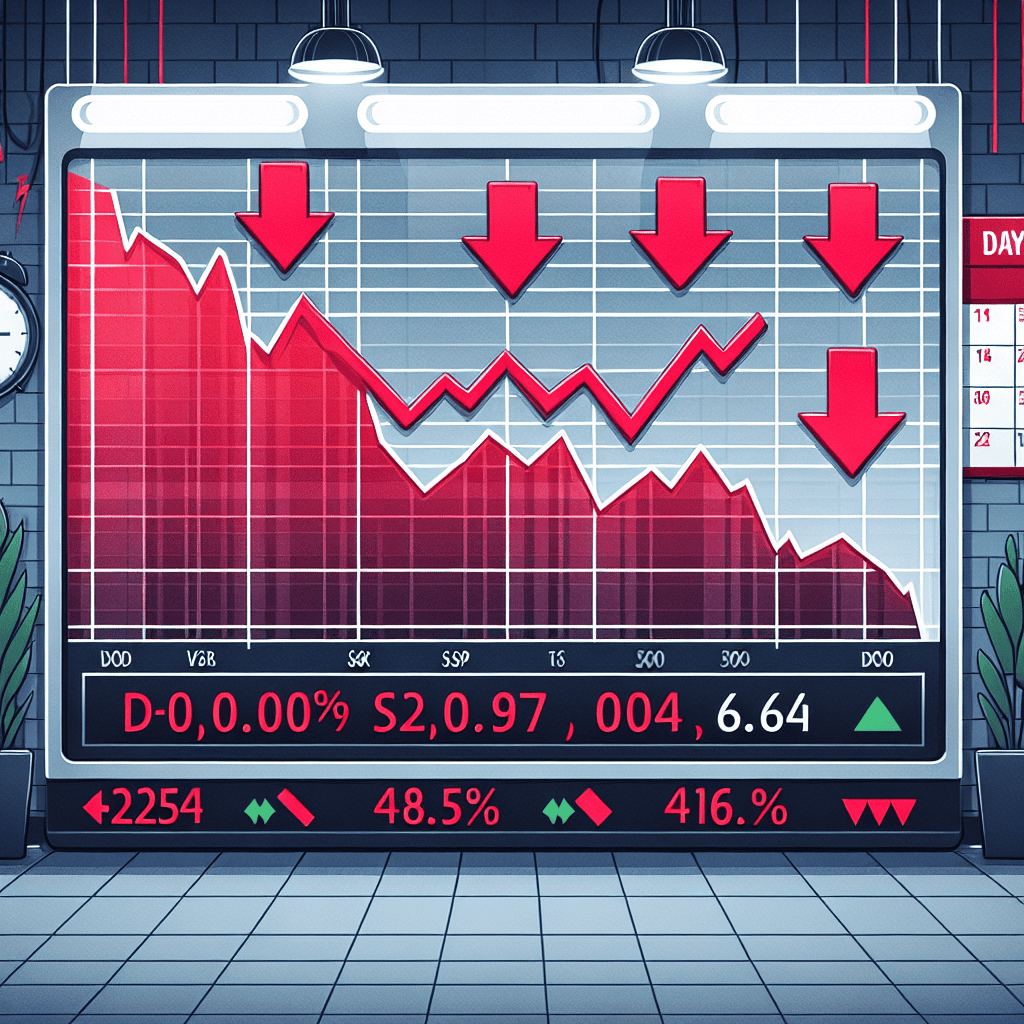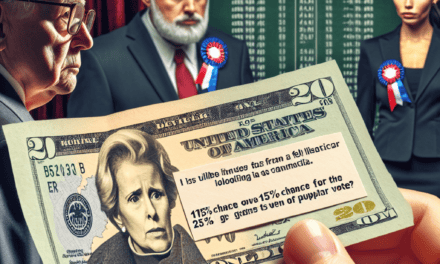“Markets Waver: Dow, S&P 500, Nasdaq Dip as Election Day Looms”
Introduction
As Election Day approaches, the stock market is experiencing notable fluctuations, with key indices such as the Dow Jones Industrial Average, the S&P 500, and the Nasdaq Composite all registering declines. This downturn reflects investor caution and uncertainty surrounding the potential economic and policy implications of the upcoming election. Market participants are closely monitoring political developments, as the outcome could significantly influence fiscal policies, regulatory changes, and overall market sentiment. The current market environment underscores the heightened volatility and sensitivity to political events, as traders and investors navigate the complex landscape of pre-election dynamics.
Impact Of Political Uncertainty On Stock Markets
As Election Day approaches, the stock market is experiencing notable fluctuations, with the Dow Jones Industrial Average, the S&P 500, and the Nasdaq Composite all showing declines. This trend underscores the significant impact that political uncertainty can have on financial markets. Investors are often wary of the unknown, and the period leading up to an election is rife with unpredictability. The potential for changes in economic policy, regulatory shifts, and geopolitical dynamics can create an environment of heightened volatility, prompting investors to adopt a more cautious approach.
Political uncertainty can manifest in various ways, influencing investor sentiment and market behavior. For instance, the anticipation of a new administration may lead to speculation about potential changes in fiscal policy, such as tax reforms or government spending initiatives. These speculations can cause fluctuations in stock prices as investors attempt to position themselves advantageously in response to anticipated policy shifts. Moreover, the possibility of regulatory changes can also weigh heavily on certain sectors, such as healthcare, energy, and technology, where government policy plays a crucial role in shaping industry dynamics.
In addition to domestic policy concerns, international relations and trade policies are also areas of focus during election periods. The outcome of an election can significantly alter a country’s stance on global trade agreements, tariffs, and diplomatic relations, which in turn can affect multinational corporations and global supply chains. Consequently, investors may become more risk-averse, leading to a sell-off in equities as they seek safer assets like bonds or gold. This shift in investment strategy can contribute to the observed declines in major stock indices.
Furthermore, the psychological aspect of political uncertainty cannot be overlooked. Investor confidence is a key driver of market performance, and uncertainty can erode this confidence, leading to increased market volatility. The fear of the unknown can prompt investors to react emotionally rather than rationally, resulting in abrupt market movements. This behavior is often exacerbated by media coverage and public discourse, which can amplify concerns and contribute to a climate of anxiety.
Despite these challenges, it is important to recognize that markets are inherently resilient and have historically rebounded from periods of political uncertainty. While short-term volatility is common, long-term investors often benefit from maintaining a disciplined approach and focusing on fundamental factors rather than transient political events. Diversification and a well-considered investment strategy can help mitigate the risks associated with political uncertainty, allowing investors to navigate turbulent times with greater confidence.
In conclusion, the declines observed in the Dow, S&P 500, and Nasdaq ahead of Election Day highlight the profound impact that political uncertainty can have on stock markets. As investors grapple with the potential implications of electoral outcomes, market volatility is likely to persist. However, by understanding the underlying factors driving these fluctuations and maintaining a long-term perspective, investors can better position themselves to weather the storm and capitalize on future opportunities. As the election unfolds and the political landscape becomes clearer, markets will gradually adjust, reflecting the new realities and paving the way for renewed stability and growth.
Historical Trends: How Elections Influence The Dow, S&P 500, And Nasdaq
As Election Day approaches, investors are keenly observing the stock market, with the Dow Jones Industrial Average, S&P 500, and Nasdaq Composite all experiencing declines. Historically, the stock market has shown a tendency to react to the political climate, particularly during election years. Understanding these historical trends can provide valuable insights into how the markets might behave in the current environment.
Historically, the stock market has exhibited a pattern of increased volatility in the months leading up to a presidential election. This volatility is often driven by uncertainty, as investors attempt to anticipate the potential economic policies of the candidates and their impact on various sectors. For instance, different administrations may prioritize different industries, such as healthcare, technology, or energy, which can lead to fluctuations in stock prices as investors adjust their portfolios accordingly.
Moreover, the performance of the stock market during an election year can be influenced by the incumbent party’s perceived economic success. If the economy is performing well under the current administration, investors may expect continuity in policies, which can lead to a more stable market. Conversely, if the economy is struggling, there may be increased speculation about a change in leadership, contributing to market instability.
Transitioning to the post-election period, historical data suggests that the stock market often experiences a relief rally once the election results are finalized. This rally is typically attributed to the resolution of uncertainty, as investors gain clarity on the future political landscape and its potential impact on economic policies. However, the magnitude and duration of this rally can vary depending on the election outcome and the market’s perception of the new administration’s economic agenda.
In examining specific indices, the Dow Jones Industrial Average, S&P 500, and Nasdaq Composite each have their unique characteristics and may respond differently to election-related developments. The Dow, being composed of 30 large-cap companies, often reflects broader economic trends and may be more sensitive to changes in fiscal policy. The S&P 500, which includes 500 of the largest U.S. companies, provides a more comprehensive view of the market and can be influenced by sector-specific policies. Meanwhile, the Nasdaq, heavily weighted towards technology stocks, may react more strongly to policies affecting innovation and regulation in the tech industry.
It is also important to consider the role of external factors that can influence market behavior during election years. Global economic conditions, geopolitical tensions, and unforeseen events such as natural disasters or pandemics can all impact investor sentiment and market performance. These factors can either amplify or mitigate the effects of election-related uncertainty, making it crucial for investors to maintain a holistic view of the market landscape.
In conclusion, while historical trends provide a framework for understanding how elections can influence the stock market, it is essential to recognize the complexity and multifaceted nature of these dynamics. Investors should remain vigilant and informed, considering both historical patterns and current events as they navigate the market during this election season. By doing so, they can better position themselves to respond to the challenges and opportunities that may arise in the weeks and months ahead.
Strategies For Investors During Election Volatility
As Election Day approaches, investors are closely monitoring the stock market, which has recently experienced declines across major indices such as the Dow Jones Industrial Average, the S&P 500, and the Nasdaq Composite. This period of heightened volatility can be attributed to the uncertainty surrounding the election outcomes and their potential impact on economic policies. In such a climate, it is crucial for investors to adopt strategies that can help mitigate risks while positioning themselves for potential opportunities.
One effective strategy during election volatility is diversification. By spreading investments across various asset classes, sectors, and geographic regions, investors can reduce the impact of market fluctuations on their portfolios. Diversification helps to balance the risk and reward, as different assets often react differently to political and economic changes. For instance, while technology stocks might experience volatility due to regulatory concerns, other sectors like utilities or consumer staples may offer more stability.
In addition to diversification, maintaining a long-term perspective is essential. Election cycles are temporary, and while they can cause short-term market disruptions, historical data suggests that markets tend to recover over time. By focusing on long-term goals and avoiding impulsive decisions based on short-term market movements, investors can better navigate the uncertainties of election periods. This approach not only helps in managing stress but also allows investors to capitalize on potential market rebounds once the political landscape stabilizes.
Moreover, investors should consider the role of cash or cash equivalents in their portfolios. Holding a portion of assets in cash can provide flexibility and liquidity, enabling investors to take advantage of buying opportunities that may arise during market dips. This strategy also serves as a buffer against potential losses, offering a sense of security amidst market turbulence. However, it is important to strike a balance, as holding too much cash can result in missed opportunities for growth.
Another strategy involves focusing on quality investments. During volatile times, companies with strong fundamentals, such as solid balance sheets, consistent earnings, and competitive advantages, are more likely to withstand market fluctuations. By prioritizing quality over speculative investments, investors can enhance the resilience of their portfolios. Additionally, dividend-paying stocks can offer a source of income and stability, as companies with a history of paying dividends are often more financially robust.
Furthermore, staying informed about economic policies and potential changes is crucial. Understanding how different election outcomes might affect sectors such as healthcare, energy, or technology can help investors make informed decisions. Engaging with financial advisors or conducting thorough research can provide valuable insights into how to adjust investment strategies in response to evolving political scenarios.
Lastly, it is important for investors to manage their emotions during periods of volatility. Market fluctuations can trigger fear and anxiety, leading to hasty decisions that may not align with long-term objectives. By maintaining discipline and adhering to a well-thought-out investment plan, investors can avoid the pitfalls of emotional trading.
In conclusion, while the stock market may experience declines ahead of Election Day, investors can employ various strategies to navigate this period of uncertainty. Through diversification, maintaining a long-term perspective, holding cash reserves, focusing on quality investments, staying informed, and managing emotions, investors can better position themselves to weather election volatility and potentially benefit from future market opportunities.
Analyzing The Pre-Election Decline In Major Indices

As Election Day approaches, the stock market is experiencing a notable decline, with major indices such as the Dow Jones Industrial Average, the S&P 500, and the Nasdaq Composite all showing downward trends. This pre-election dip is not entirely unexpected, as markets often exhibit volatility in the lead-up to significant political events. Investors are closely monitoring the situation, trying to gauge the potential impact of the election results on economic policies and, consequently, on market performance.
The Dow Jones Industrial Average, a key indicator of the overall health of the stock market, has seen a decrease in recent trading sessions. This decline can be attributed to a combination of factors, including investor uncertainty about the election outcome and its implications for fiscal policy. Historically, markets tend to react to the perceived stability or instability that a new administration might bring. As such, the current decline reflects a cautious approach by investors who are hedging against potential risks.
Similarly, the S&P 500, which represents a broader spectrum of the market, has also experienced a downturn. This index, comprising 500 of the largest companies listed on stock exchanges in the United States, serves as a barometer for the overall market sentiment. The decline in the S&P 500 suggests that investors are not only concerned about the election but are also wary of other economic factors, such as inflationary pressures and interest rate hikes. These concerns are compounded by ongoing global issues, including supply chain disruptions and geopolitical tensions, which continue to weigh heavily on investor confidence.
Meanwhile, the Nasdaq Composite, heavily weighted towards technology stocks, has not been immune to the pre-election jitters. The tech sector, which has been a significant driver of market gains in recent years, is particularly sensitive to changes in regulatory policies that could arise from a shift in political power. Investors are therefore re-evaluating their positions in tech stocks, leading to increased volatility in this index. Moreover, the potential for increased scrutiny and regulation of big tech companies under a new administration adds another layer of uncertainty.
In addition to these political considerations, the market is also reacting to recent economic data releases. Reports indicating slower-than-expected growth in key sectors have further fueled concerns about the strength of the economic recovery. This has led to a reassessment of corporate earnings forecasts, contributing to the downward pressure on stock prices. Furthermore, the Federal Reserve’s monetary policy stance remains a critical factor influencing market dynamics. Any indications of a shift towards more aggressive interest rate hikes could exacerbate the current decline.
Despite these challenges, it is important to note that market fluctuations in the run-up to elections are not uncommon. Historically, markets have often rebounded after the election results are finalized, as investors gain clarity on the future policy direction. Therefore, while the current decline in major indices may be unsettling, it is essential to view it within the broader context of market cycles and political transitions.
In conclusion, the pre-election decline in the Dow, S&P 500, and Nasdaq reflects a complex interplay of political uncertainty, economic data, and investor sentiment. As Election Day draws nearer, market participants will continue to navigate these uncertainties, seeking to position themselves advantageously for the post-election landscape. While the immediate outlook may appear challenging, the long-term trajectory of the market will ultimately depend on the policies and economic conditions that emerge in the aftermath of the election.
Expert Predictions: Post-Election Market Recovery
As the stock market experiences a downturn with the Dow, S&P 500, and Nasdaq all declining ahead of Election Day, investors and analysts alike are keenly observing the potential for a post-election market recovery. Historically, the stock market has shown a tendency to react to political events, and the upcoming election is no exception. The uncertainty surrounding the election outcome often leads to market volatility, as investors grapple with the potential implications of different political scenarios on economic policies and regulations. However, many experts suggest that a post-election recovery is likely, driven by several key factors that could stabilize and potentially boost market performance.
Firstly, it is important to consider the historical patterns that have emerged in past election cycles. Typically, the stock market tends to experience a period of volatility leading up to an election, as investors adjust their portfolios in anticipation of potential policy changes. However, once the election results are clear, markets often stabilize and, in many cases, rally. This pattern is attributed to the resolution of uncertainty, which allows investors to make more informed decisions based on the new political landscape. Consequently, the removal of election-related uncertainty could serve as a catalyst for market recovery.
Moreover, the potential for fiscal stimulus is another factor that could contribute to a post-election market rebound. Regardless of the election outcome, there is a strong likelihood that the government will implement additional fiscal measures to support the economy, particularly in light of ongoing challenges such as inflation and supply chain disruptions. Such stimulus packages could provide a significant boost to consumer spending and business investment, thereby enhancing corporate earnings and, in turn, stock market performance. Investors are closely monitoring the policy proposals of both political parties, as these will shape the nature and extent of any forthcoming fiscal interventions.
In addition to fiscal policy, monetary policy will also play a crucial role in shaping the post-election market environment. The Federal Reserve’s stance on interest rates and its broader monetary policy framework will be pivotal in influencing investor sentiment and market dynamics. A continuation of accommodative monetary policy, characterized by low interest rates and quantitative easing, could support asset prices and encourage risk-taking among investors. Conversely, any indications of tightening monetary policy could introduce new challenges for the market, although such moves are generally communicated well in advance to minimize market disruptions.
Furthermore, the global economic context cannot be overlooked when considering the prospects for a post-election market recovery. The interconnectedness of global markets means that developments in major economies, such as China and the European Union, will inevitably impact U.S. market performance. Positive developments in global trade relations, as well as progress in addressing international challenges such as climate change and geopolitical tensions, could bolster investor confidence and contribute to a more favorable market environment.
In conclusion, while the current decline in the Dow, S&P 500, and Nasdaq ahead of Election Day may be cause for concern, there are several reasons to remain optimistic about the potential for a post-election market recovery. Historical patterns, the prospect of fiscal and monetary support, and the broader global economic context all suggest that the market could rebound once election-related uncertainties are resolved. As always, investors are advised to remain vigilant and informed, carefully considering the evolving political and economic landscape as they make their investment decisions.
Comparing Current Market Trends With Previous Election Years
As Election Day approaches, the stock market is experiencing a notable decline, with the Dow Jones Industrial Average, S&P 500, and Nasdaq Composite all showing downward trends. This phenomenon is not entirely unexpected, as historical patterns suggest that market volatility often increases in the lead-up to major political events. By comparing current market trends with those observed in previous election years, investors can gain valuable insights into the potential implications for their portfolios.
Historically, the stock market has exhibited a tendency to react to the uncertainty that accompanies presidential elections. This is largely due to the potential for significant policy changes that can impact various sectors of the economy. For instance, in the months leading up to the 2016 election, the market experienced fluctuations as investors grappled with the potential outcomes of the race between Donald Trump and Hillary Clinton. Similarly, in 2012, the market showed signs of volatility as Barack Obama and Mitt Romney vied for the presidency. These examples underscore the market’s sensitivity to political developments and the anticipation of policy shifts.
In the current election cycle, the market’s decline can be attributed to several factors. First, there is the uncertainty surrounding the potential economic policies of the candidates. Investors are keenly aware that different administrations prioritize different economic agendas, which can have varying impacts on industries such as healthcare, energy, and technology. This uncertainty can lead to cautious behavior among investors, resulting in decreased market activity and, consequently, a decline in stock prices.
Moreover, the ongoing global economic challenges, including inflationary pressures and supply chain disruptions, have compounded the market’s apprehension. These issues have created an environment where investors are already on edge, and the added uncertainty of an election only exacerbates their concerns. As a result, the market’s response is more pronounced than in previous election years when the economic backdrop was relatively stable.
Despite these challenges, it is important to note that the market’s reaction to elections is often temporary. Historically, once the election results are finalized and the new administration’s policies become clearer, the market tends to stabilize. For example, following the 2016 election, the market initially reacted with volatility but eventually rallied as investors adjusted to the new administration’s policy direction. This pattern suggests that while the current decline may be unsettling, it is not necessarily indicative of a long-term trend.
Furthermore, it is worth considering that the market’s performance in election years is not solely determined by political factors. Broader economic indicators, such as corporate earnings, interest rates, and global economic conditions, also play a significant role in shaping market trends. Therefore, while the election is a critical factor, it is not the sole driver of market behavior.
In conclusion, the current decline in the Dow, S&P 500, and Nasdaq ahead of Election Day is consistent with historical patterns observed in previous election years. While the uncertainty surrounding potential policy changes and existing economic challenges has contributed to market volatility, it is important for investors to maintain a long-term perspective. By understanding the interplay between political events and broader economic factors, investors can better navigate the complexities of the market during election years and beyond.
The Role Of Economic Policies In Shaping Market Sentiment
As Election Day approaches, the stock market is experiencing a notable decline, with the Dow Jones Industrial Average, S&P 500, and Nasdaq Composite all showing downward trends. This movement in the market is not merely a reflection of investor sentiment but is deeply intertwined with the economic policies that are anticipated to emerge from the election results. Understanding the role of these policies in shaping market sentiment is crucial for investors and analysts alike.
Economic policies, whether fiscal or monetary, have a profound impact on market dynamics. Fiscal policies, which include government spending and tax policies, directly influence economic growth and corporate profitability. For instance, an anticipated increase in government spending can lead to higher economic growth, which in turn boosts corporate earnings and stock prices. Conversely, expectations of higher taxes can dampen corporate profits and reduce investor enthusiasm, leading to a decline in stock prices. As the election draws near, investors are closely monitoring the policy platforms of the candidates, trying to gauge how these might affect the economic landscape.
Monetary policy, primarily managed by the Federal Reserve, also plays a critical role in shaping market sentiment. Interest rates, set by the Federal Reserve, influence borrowing costs for businesses and consumers. Lower interest rates generally encourage borrowing and investing, leading to economic expansion and higher stock prices. On the other hand, higher interest rates can slow down economic activity and negatively impact stock valuations. As investors anticipate potential shifts in monetary policy post-election, market volatility is likely to increase.
Moreover, trade policies are another significant factor that investors consider when evaluating market conditions. Trade agreements and tariffs can have substantial effects on international trade flows and corporate supply chains. Policies that promote free trade are generally viewed favorably by the market, as they can lead to increased economic activity and growth. However, protectionist policies may lead to trade tensions and economic uncertainty, which can weigh heavily on market sentiment. As such, the potential for changes in trade policy following the election is a key concern for investors.
In addition to these economic policies, regulatory policies also play a pivotal role in shaping market sentiment. Regulations can affect various sectors differently, with some industries benefiting from deregulation while others may face increased compliance costs. For example, the technology sector, represented by the Nasdaq Composite, is particularly sensitive to regulatory changes, as increased scrutiny and regulation can impact innovation and profitability. Investors are therefore keenly aware of the regulatory stances of the candidates and how these might influence specific sectors.
In conclusion, as the stock market experiences a decline ahead of Election Day, it is evident that economic policies play a crucial role in shaping market sentiment. Investors are not only reacting to current market conditions but are also trying to anticipate the future policy landscape and its implications for economic growth and corporate profitability. By understanding the interplay between fiscal, monetary, trade, and regulatory policies, investors can better navigate the complexities of the market and make informed decisions. As the election results unfold, the market will continue to respond to the evolving economic policy environment, underscoring the importance of these policies in influencing investor behavior and market trends.
Q&A
1. **Question:** What was the performance of the Dow Jones Industrial Average ahead of Election Day?
– **Answer:** The Dow Jones Industrial Average declined ahead of Election Day.
2. **Question:** How did the S&P 500 perform in the stock market update before Election Day?
– **Answer:** The S&P 500 experienced a decline before Election Day.
3. **Question:** What was the trend for the Nasdaq Composite in the stock market update leading up to Election Day?
– **Answer:** The Nasdaq Composite also saw a decline ahead of Election Day.
4. **Question:** What were investors concerned about in the stock market update before Election Day?
– **Answer:** Investors were concerned about the uncertainty surrounding the upcoming election and its potential impact on the market.
5. **Question:** How did the uncertainty of the election affect market volatility?
– **Answer:** The uncertainty of the election contributed to increased market volatility.
6. **Question:** Were there any specific sectors that were particularly affected by the market decline?
– **Answer:** Technology and financial sectors were among those particularly affected by the market decline.
7. **Question:** What was the general sentiment among investors regarding the stock market ahead of Election Day?
– **Answer:** The general sentiment among investors was cautious and apprehensive due to the looming election and its possible implications.
Conclusion
In the lead-up to Election Day, the stock market experienced a downturn, with the Dow Jones Industrial Average, S&P 500, and Nasdaq Composite all recording declines. This movement reflects investor uncertainty and caution as they anticipate potential policy changes and economic impacts resulting from the election outcome. Market participants are likely adjusting their portfolios in response to perceived risks and opportunities, highlighting the influence of political events on financial markets. The declines underscore the volatility and sensitivity of the stock market to external factors, particularly significant political events.




